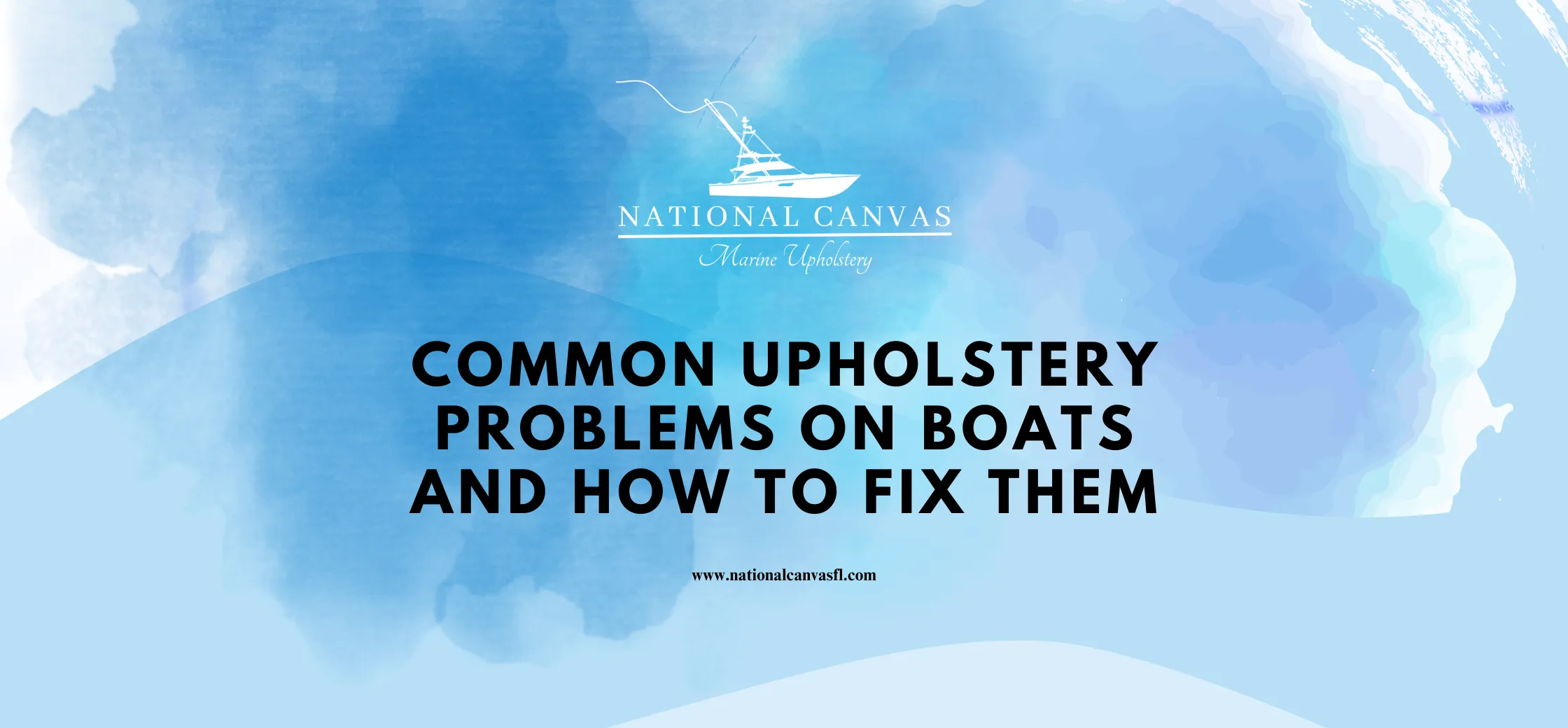Your boat’s upholstery is constantly exposed to sun, salt, and moisture. Over time, these conditions lead to visible wear that affects your comfort and your boat’s value. The good news? Most of these issues can be fixed or prevented if caught early.
This guide walks you through the most common boat upholstery problems and exactly how to fix them. Whether you’re dealing with cracking vinyl or musty cushions, you’ll find clear solutions here.
Common Problems You’ll Learn to Fix
- Cracking and peeling marine vinyl
- Mold and mildew in cushions
- Sun-faded boat seats
- Seam separations and thread breakdown
- Sagging or water-logged foam
- Rust damage under seating
1. Cracked or Peeling Marine Vinyl
Let’s start with the most visible issue.
You might notice flaking edges, dryness along the seams, or surfaces that feel rough and brittle. Once vinyl starts peeling, it only gets worse with exposure.
Why it happens:
- Constant UV exposure
- Age and poor material quality
- Harsh cleaning chemicals or neglect
How to fix it:
- Minor cracks: patch with marine vinyl repair kits
- Larger areas: replace the panel or cushion
- Protect surfaces with UV-blocking sprays after every cleaning
Upgrading to UV-resistant materials through custom upholstery services gives you longer-lasting results.
2. Mold or Mildew in Boat Cushions
Musty smells and dark spots on your seats often point to mold in boat cushions. This isn’t just a cosmetic problem. It can lead to health concerns and interior decay.
Why it happens:
- Trapped moisture in foam
- Poor ventilation
- Damp boat storage environments
How to fix it:
- Strip cushion covers and clean with a white vinegar solution
- Dry foam completely in sunlight
- If foam is saturated or smells deeply, replace it entirely
- Use moisture-wicking foam or ventilated seating designs
Pairing new upholstery with breathable boat covers can stop mold before it starts.
3. Sun-Faded or Discolored Seats
Faded seats make even a well-maintained boat feel tired. You’ll often see patchy coloring, dullness, or yellowing on white vinyl.
Why it happens:
- Intense UV exposure
- Incorrect cleaners removing protective coating
- Low-quality marine materials
How to fix it:
- Re-dye or repaint using vinyl restoration products
- Replace covers if fading is deep or permanent
- Apply UV protectant routinely after each wash
Adding a custom top or sun shade helps shield seats from ongoing sun damage.
4. Seam Separation or Thread Breakdown
Loose seams are more than an eyesore. They can unravel quickly and allow water to seep into the foam.
Why it happens:
- UV breakdown of thread
- Weight stress from repeated use
- Poor original stitching
How to fix it:
- Small gaps: hand-stitch with marine-grade thread
- Larger separations: have the panel professionally restitched
- Consider reinforcement stitching for high-use areas
We recommend contacting boat upholstery specialists who use double-stitched seams for better durability.
5. Foam Breakdown or Sagging Seats
If your seat feels squishy, holds water, or stays damp for hours, the foam inside has likely deteriorated.
Why it happens:
- Water-absorbent foam without drainage
- Compression over years of use
- Mold growth inside unventilated seating
How to fix it:
- Replace old foam with marine-grade quick-dry or closed-cell foam
- Use vented cushion bases to improve drainage
- Ensure the fit is exact using CNC cutting services
Quick-dry foam is worth the upgrade, especially in humid or rainy regions like South Florida.
6. Rust or Corrosion Under Upholstery
If your vinyl shows orange stains or feels rough from beneath, hidden rust could be the problem.
Why it happens:
- Saltwater exposure
- Uncoated metal frames or fasteners
- Water pooling beneath cushions
How to fix it:
- Remove the cover and inspect the seat frame
- Clean rust with marine-grade rust remover
- Replace corroded hardware with stainless steel or coated parts
Using sun shades or full enclosures can protect from ongoing salt exposure.
When DIY Isn’t Enough: Trust the Experts
Some upholstery problems can’t be solved with patches or store-bought kits. If multiple issues stack up or mold keeps coming back, it’s time for professional help.
At National Canvas, we serve boat owners across Delray Beach, Boca Raton, and coastal Florida with high-quality marine upholstery repair. Our team uses the right vinyl, foam, stitching, and fit techniques to restore your boat to peak condition.
You can also visit us directly on Google Maps to learn more about our location and services.
Frequently Asked Questions
What causes cracking in boat upholstery?
UV rays, dry air, and improper cleaning products cause marine vinyl to harden and split.
How can I remove mold from boat cushions?
Vinegar or enzyme cleaners can work for surface mold. But deep mold in the foam requires full cushion replacement.
How long does marine upholstery usually last?
With marine-grade materials and regular care, 7 to 10 years is typical for boat upholstery.
Can faded boat seats be restored without replacing them?
Mild fading can be improved with vinyl re-dye products. But heavy discoloration often requires new covers.
Does fixing these problems increase resale value?
Absolutely. Clean, restored interiors show buyers the boat is well maintained and reduce negotiation losses.
Final Thoughts: Stay Ahead of the Damage
Boat upholstery problems don’t fix themselves. If you’ve noticed cracking, fading, mold, or rust, now’s the time to act.
Need help today? Request expert marine upholstery repair or call National Canvas to schedule your restoration. Your boat’s next season should start fresh, dry, and ready.

